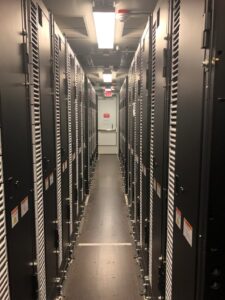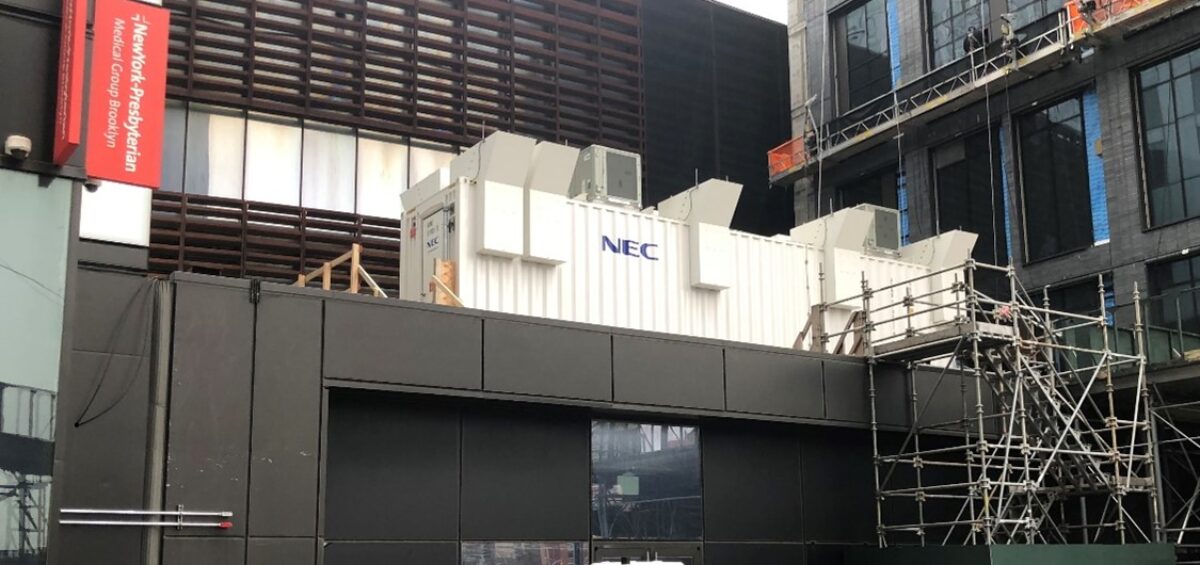It seems anyone you speak to these days is familiar with Lithium-Ion battery technology, but not as many are familiar with Battery Energy Storage Systems (BESS). A BESS is as it sounds, it’s a series of batteries that are arranged in a system to store energy to be used at a later time. Typically, a BESS consists of multiple batteries that start at the cell level which can range in shape and size from pouches to cylinders. For simplicity, think of an extremely large AA battery. At its core, a battery is comprised of many cells. To facilitate the construction of a BESS, these cells are arranged into modules that contain many cells, and then modules are arranged into racks, which are then arranged into the actual system based on needs. These systems are typically controlled by a Battery Management System (BMS) or Energy Management System (EMS) that, in addition to regulating the charging and discharging of the system, may monitor copious amounts of other criteria. Two FDNY-related processes for battery energy storage systems in NYC are the BESS Certificate of Approval and BESS Site-Specific filing, both of which are explained in more detail below.
BESS Certificate of Approval (Equipment)
All battery energy storage systems (BESS) with a rated energy capacity of 2 kWh and larger in New York City (NYC) require a BESS Certificate of Approval (COA) issued by the New York City Fire Department (FDNY). This includes residential BESS systems, flow batteries, Uninterruptible Power Supplies (UPS), Lead-Acid, Nickle Cadmium (Ni-Cd) or Nickel-Metal Hydride (NiMH) Battery systems, and others. There are currently only nine (9) energy storage systems (ESS) approved for use in NYC with their BESS Certificate of Approval, which can be found here.
The FDNY TM-2 Application for BESS Certificate of Approval (COA) covers many items used throughout NYC. The Form must be submitted to the FDNY along with the information consisting of, but not limited to, the following:
- Narrative including system size in kWh and kW, and specifics of the battery system.
- Data/cut sheets, Installation and Operation Manuals
- Material Safety Data Sheets (MSDS)
- Underwriters Laboratories (UL) listings including UL9540, UL 9540A, UL 1973 and UL 1741
- Hazard Mitigation Analysis (HMA) prepared by New York State Licensed Design Professional (Professional Engineer or Registered Architect), preferably a fire protection Engineer (FDNY’s words). The HMA must also consider the UL 9540A testing results with a failure mode and effects analysis.
- Emergency Response/Management Plan
The form and documents are provided to FDNY for review in addition to the payment of a filing fee.
The COA expires after three (3) years, when the entire process must be completed again. During the renewal of the COA there may be additional requirements based on new industry standards or rules/codes adopted by NYC.
How about BESS Site-Specific Approval
After a COA is obtained for a BESS it may also require a site-specific approval filing depending on the system size. The table below defines whether a BESS is considered Small, Medium or Large. Small systems do not require filing with FDNY or DOB for approval, whereas Medium systems require inspections and Large systems require filings with the DOB and FDNY. This article is intended to address FDNY filing requirements only and does not provide information on the requirements of the New York City Department of Building’s. Note that approval to install a BESS at a site also requires approval from the New York City Department of Buildings Office of Technical Certification and Research (OTCR) through the submission of an OTCR-2 Form.
The FDNY filing requires a Form TM-1 Application for Technology Management Plan Examination/Document review to be submitted for review and approval, along with the following which is not an all-inclusive list:
- Narrative including system size in kWh and kW, and specifics of the battery system.
- Site plans including flood plane elevation and a variety of other information required by the codes and rules, as well as deemed necessary as part of the site specific approval process.
- Data/cut sheets, Installation and Operation Manuals
- Material Safety Data Sheets (MSDS)
- Underwriters Laboratories (UL) listings including UL9540, UL 9540A, UL 1973 and UL 1741
- Hazard Mitigation Analysis (HMA) specific to the site prepared by New York State Licensed Design Professional (Professional Engineer or Registered Architect), preferably a fire protection Engineer (FDNY’s words). The HMA must also consider the UL 9540A testing results with a failure mode and effects analysis.
- Emergency Response/Management Plan (ERP / EMP) specific to the site.
|
Battery Technology |
Aggregate Rated Energy Capacity | ||
| Small | Medium | Large | |
| Lead Acid Battery | >2 kWh and ≤70 kWh | >70 kWh and ≤500 kWh | > 500 kWh |
| Ni-Cd Battery | >2 kWh and ≤70 kWh | >70 kWh and ≤500 kWh | > 500 kWh |
| NiMH Battery | >2 kWh and ≤70 kWh | >70 kWh and ≤500 kWh | > 500 kWh |
| Li-ion Battery | >2 kWh and ≤20 kWh | >20 kWh and ≤250 kWh | > 250 kWh |
| Flow Battery | >2 kWh and ≤20 kWh | >20 kWh and ≤500 kWh | > 500 kWh |
The form and documents are provided to FDNY for review in addition to the payment of a filing fee.
Additional BESS Requirements
Part of the COA and Site-specific applications allow the FDNY to review BESS as a whole, analyze testing documents, and determine if additional safety measurements are required.
The following are some additional requirements that are not typically provided with BESS by manufacturers or designers, and may even be NYC specific:
- Fire Extinguishing System – a fire extinguishing system is required for Large systems, unless not required by testing documents or part of the COA process. The final requirements will be determined as part of the BESS COA, but an open nozzle fixed water spray system in accordance with NFPA 15 is required. For outdoor installations, the system must wet all exterior surfaces with the prescribed water densities.
-
- Fire Department Connections (FDC) are required for the systems. Special care must be considered as to the safe distance from the BESS for firefighters to connect hoses during a fire event.
-
- Explosion Mitigation – Explosion Mitigation is required for Large systems unless not required by testing documents or part of the COA process. Explosion mitigation is required to be provided in accordance with either NFPA 68 or 69 and consider the UL9540A test results or other approved test data. The venting of an explosion must also consider firefighters, egress paths and adjacent exposures.
- Fire Detection & Alarm System – a fire detection & alarm system compliant with NYC codes is required for Medium and Large BESS installations, unless not required by testing documents or part of the COA process. Unless permitted otherwise by the BESS COA or Site-Specific approval, the automatic fire detection system must be installed within the BESS enclosure (e.g. the room, cabinet, walk-in unit, etc.) and shall communicate alarm locally. In addition, it must communicate to a central station for FDNY dispatch, activate other mitigation measures such as venting, and where warranted, must also shut down battery system.
- Gas Detection – a gas detection system is required based on battery type and system size as shown in the table below. The system, like the fire detection and alarm system, must annunciate an alarm, activate other mitigation measures such as venting, and where warranted, shut down battery system where warranted and shut down battery system.
| BESS Type | Small | Medium | Large |
| Lead Acid (all types) | Yes | Yes | Yes |
| Ni-Cd and NiMH | Yes | Yes | Yes |
| Li-Ion | No | No* | No* |
| Flow | Yes | Yes | Yes |
| * Unless required as a condition of equipment approval based on full-scale testing or part of the COA approval as deemed necessary by the FDNY. | |||
- Ventilation System – a ventilation system is required for Large systems, unless not required by testing documents and part of the COA process. The intent of the ventilation system is to maintain optimal operating conditions including temperature and maintenance of any toxic or flammable gases below 25 percent of the permissible exposure limit (PEL).
- Smoke/Gas Purge System – a smoke/gas purge system is required for Large systems, unless not required by the COA process. The system is required to be manually operated by responding firefighter personnel to exhaust heat, smoke and toxic gases generated by the BESS during abnormal operating conditions.
- Site Specific – In addition to the above, there are requirements for setbacks, signage, fencing, fire hydrants, remote monitoring, recordkeeping and others.
- Specific Personnel – Once the site is constructed, the FDNY requires a Certificate of Fitness (CoF B28) holder for every BESS installation site, to be readily available upon request. This information is requested early on in the application process, but may not be fulfilled until later in the process.
Obtaining a BESS Certificate of Approval or Site-specific approval is a complex process that requires a significant amount of time for both design professionals engineering a site, as well as for the FDNY in their review of the documents. Our recommendation is always to start this process as early as possible. Sparc can assist on the BESS Certificate of Approval or site-specific approvals, through code consulting, fire alarm and fire protection systems design, filing services, and post-construction system testing or Bulk Fuel Safety Unit inspections. Contact us with questions about the process!



Leave a Comment